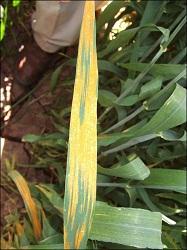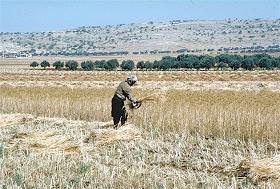Using AI to control energy for indoor agriculture
30 September 2024
Published online 26 May 2010

A dangerous wheat rust fungus that can eradicate complete fields of crops just got worse, with the spread across borders of a new mutation that can affect previously resistant wheat strains.
The new strain of stripe rust, sometimes called yellow rust, has hit countries in the Middle East surrounding the Tigris and Euphrates rivers, affecting Turkey, Syria, Lebanon and Iraq. It has also affected areas of Central Asia and the Caucasus region. Researchers say that a combination of warmer weather and high humidity is behind the rapid spread.
"It is too early to say what the damage is," said Amor Yahyaoui, who is a senior cereal pathologist coordinator at the International Center for Agricultural Research in the Dry Areas (ICARDA). "In a few weeks we will be able to know how bad it is because what you see is not always what you get. However, most of the [affected Middle Eastern countries] might have lost 15–20% of their yield."
The varieties that were being cultivated across the region that had resistance genes in the past are actually more susceptible now.
A mild winter and some rain in early March allowed fast growth of the wheat fields in the Middle East. This was followed by a dry period of nearly a month. The humidity of the irrigated fields was ideal for fast multiplication of the fungus. When the rain finally came in late April, it helped spread across fields the fungal spores that were in the air, leading to a high infection rate. "By then, most fields were at heading growth stage and that discouraged farmers from entering their fields for fungicide spraying," explained Yahyaoui.
In Uzbekistan, a change in weather patterns led to a change in the timing of the stripe rust cycle. "Because of a mild winter, yellow rust came very early, almost 1 month before we were expecting it," explained Ram Sharma, who is a researcher with ICARDA in the Caucasus region. "Mutations of the fungus that were very rare in the past increased due to the warmer weather."
"The varieties that were being cultivated across the region that had resistance genes in the past are actually more susceptible now."
The gene in wheat that is mainly responsible for resistance to stripe rust is Yr27. However, it fails to stop the new mutations of the pathogen.
The new strain "is expected to cause billions of dollars in crop losses and disrupt regional government's food security plans through loss of yield," said ICARDA director Mahmoud Solh in a press release.

Stripe rust is caused by the fungus Puccinia striiformis. It produces orange-yellow spores on the upper surface of the leaves, the leaf sheaths and awns of wheat. The spores produce small pustules that form stripes parallel to the veins in the leaf.
The fungus requires a cool weather and high humidity to infect the wheat at any stage of growth.
Through ICARDA and the International Maize and Wheat Improvement Center (CIMMYT), researchers from different countries in the region are collaborating by monitoring wheat nurseries. The scientists in these centres collect information about the different strains of wheat rust to monitor the spread of the fungus. This information is shared across borders to map the spread of the pathogen in an attempt to limit its spread.
"The problem is that once they get to an epidemic level, they are very hard to stop," said Ravi Singh, who is a senior scientist in plant genetics and pathology at CIMMYT, in a press release. "In a raging epidemic, even chemicals are of limited use."
ICARDA is working with regional partners to spread wheat varieties with resistance genes for stripe rust. The wheat that is produced in its breeding greenhouses is available to all countries to adopt into their national programmes. They can then apply their own strategies to roll out these new varieties to replace susceptible ones.
Syria cultivates ~1.7 million hectares of wheat every year, while Egypt and Iraq each harvest >1 million hectares annually. Breeding programmes can take some time to produce enough seeds for use in all these fields.
"Usually it takes 2–3 years to have enough seeds to be distributed to the farmers," explained Yahyaoui. "But Syria has some resistant varieties and has been looking at how they can fast-track seed multiplication. They probably won't make it this year, but may be able to start using them in the field next year."
Researchers and wheat experts representing every region of the world will gather in Saint Petersburg, Russia, 1 - 4 June, 2010, to discuss collaborative efforts to monitor and stop the spread of all the different forms of wheat rust. The important question, according to Solh, is whether policy-makers around the world will be ready to provide the ongoing support needed to face future challenges.
doi:10.1038/nmiddleeast.2010.154
Stay connected: